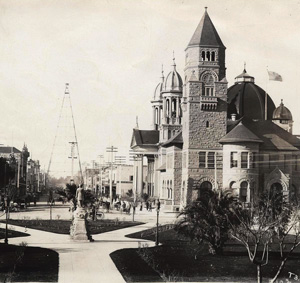

WHEN David Earl McDaniel donated his massive collection of sheet music to the San Jose Public Library in 1946, the library was located at Market and San Fernando streets, where the San Jose Museum of Art now sits. At that time, McDaniel probably had no idea that the collection would still remain in that celebrated institution more than 60 years later.
These days, the California Room at the King Main Library—now located at Fourth and San Fernando streets—still owns that collection of sheet music, something like 12,000 titles. Since there’s no way to possibly implement public browsing of the whole collection, one must search the catalog by title and then ask the librarian to fetch the music and bring it out.
The collection includes pop standards, old torch classics, jazz, blues, novelty songs, easy listening, show tunes and all sorts of forgotten oddities from the Great American Songbook, all thanks to McDaniel.
One of the San Jose Public Library’s greatest benefactors of the 20th century, McDaniel was a legendary eccentric in these parts. An amateur poet and crooner who graduated from San Jose High in 1926, McDaniel spent his life collecting thousands of books, eventually donating all of them to various departments of the library. He died in 1977, a 70-year-old bachelor, and the books he donated had a combined worth of more than $100,000. After his passing, the library even named a community room after him, the only time they had ever done such a thing.
It gets even better. McDaniel’s mammoth collection of sheet music, along with an equally insane collection of records and music books, helped justify what came to be called the Music Room at the old Market and San Fernando location, an entirely separate department with its own card catalog, which opened in 1949.
Eight years later, another massive donation showed up, this one on behalf of the widow of Dr. C.M. Richards, former leader of Elks Concert Orchestra, the main gig around here before the San Jose Symphony officially launched in 1937. Richards also conducted his own men’s chorus, and the donation made by his widow included an entire catalog of men’s choral music, plus a large group of opera vocal scores and miniature orchestra scores.
Most of that sheet music is still located in the California Room today. For example, one file cabinet features titles from “Emaline” to “Flower of Araby.” The last title in the collection is “Zoot Suit.”
Eventually, as the ’60s progressed, the Music Room evolved into an unprecedented multimedia endeavor for a public library. In a library document from 1964, Peggy Kraynick, then head of the Music Room, explained the facility had “record players in four of the listening booths, a piano which may be used for one hour at a time, an old Edison cylinder machine which can be used to demonstrate early recordings, a 16mm projector and screen for library use, and two slide and filmstrip projectors. The Talking Book recordings and Projected Books on 35mm film are housed and circulated from the Music Room to blind and handicapped patrons.”
Continuing, Kraynick explained that the Music Room had become a charter member of the Northern California Film Circuit in 1953 and, by 1964, had owned 100 films, all the while receiving 20 titles a month from the circuit. At that time, the department also offered 400 filmstrips for circulation, complete with guides and recordings to accompany them. Eight hundred 78s and 1,500 mono LPs made up the record collection.
“The development of the Music Room has been a combination of ‘learn-as-you-go’ and ‘do-it-yourself’ experiments,” wrote Kraynick in 1964. “By observing routines in similar departments in other libraries, we have developed one of the outstanding film and record lending services in Northern California.”
Thanks to those librarians, the legend lives on, at least in this columnist’s head. When I slithered into the main library on San Carlos Street in 2000, in order to photocopy tunes like “Satan Takes a Holiday” and “Laugh, Clown, Laugh,” I had no idea those exact pieces of sheet music were donated by McDaniel decades earlier. Just like a snake eating its own tail, everything seems to be coming full circle.



